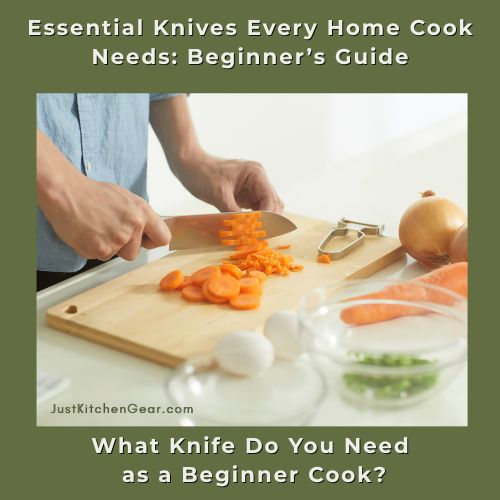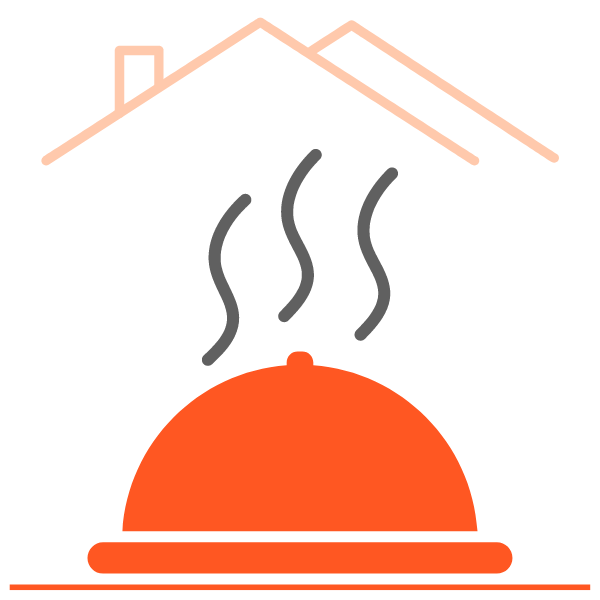*This post may contain affiliate links for which I earn commissions.*

Cooking from scratch is more enjoyable and easier when you have the right tools. And nothing is more essential in the kitchen than a good knife. But if you’re new to cooking, you may be asking yourself the question: What knife do you need as a beginner cook?
All those knives in stores or online can feel overwhelming. Chef’s knife, paring knife, bread knife, so where do you even start?
Don’t worry! This guide will help you understand the different types of knives, what you really need as a beginner, and tips for choosing knives that make cooking at home safer and more enjoyable.
Why Choosing the Right Knife Matters
A good knife can make chopping, slicing, and dicing faster, safer, and more precise. A dull or poorly balanced knife can slow you down and even cause accidents. Investing a little time in learning which knives are essential for beginners will pay off every time you step into the kitchen.
I cook a Sunday roast for an older person in our town, but her knives are so blunt that I had to take my own along to carve the meat for her. Her dull knife required so much more effort, and I was worried that extra pressure might cause me to cut myself. Sharp, quality knives cut thin slices of meat with less effort.
The Essential Knives Every Beginner Should Have
You don’t need a drawer full of knives to cook well. Here are the basics:
1. Chef’s Knife
- Size: Usually 8–10 inches
- Uses: Chopping carrots, courgettes, brinjals, potatoes for our evening meal , slicing chicken breasts into bite-sized portions, beef, chopping up parsley, rosemary or chives.
- Why it’s essential: This is my all-purpose workhorse. Most of my daily chopping will be done with this knife. I use mine every day and several times a day.
2. Paring Knife
- Size: 3–4 inches
- Uses: Peeling, trimming, and detailed cutting, as with preparing apples to be cooked
- Why it’s essential: Perfect for small tasks that require precision, where you need a smaller blade.
3. Serrated Knife (Bread Knife)
- Size: 8–10 inches
- Uses: Cutting home-made sourdough bread baked in my breadmaker, bread rolls, or other soft foods with a tough skin
- Why it’s essential: The serrated edge of this knife cleanly slices the bread using a sawing action without squashing it up.
I like to bake sourdough bread in my machine, as my husband just loves it. If you have to eat bread, this type has been reported to be the best for nutrition. It makes a small but tall loaf which, as you can imagine, is quite hard to slice. I have an old (left to me by my parents) good-quality serrated bread knife that makes slicing this loaf so easy. The slices are frozen in a Ziploc bag ready for when they’re needed.
Optional: As you become more confident and adventurous, you might add a boning knife for meat or a long, thin carving/slicing knife for cutting those Sunday roasted joints. But these three knives are all you really need to start cooking.
How to Choose the Right Knife for Your Kitchen
When picking your first knives, consider these tips:
- Comfort and Balance: Hold the knife, does it feel comfortable? A knife that’s too heavy or unbalanced can be tiring and unsafe.
- Material: Stainless steel is common and low-maintenance. High-carbon steel holds a sharper edge but may need more care.
- Budget: You don’t need to spend a fortune. Good beginner knives can be purchased for £10 and above.
- Maintenance: Some knives need frequent sharpening. Make sure you’re ready to maintain your knife, or opt for a low-maintenance option.
Knife Care Tips for Beginners
A knife is only as good as the care it gets. Follow these simple rules:
- Wash by hand and dry immediately. Avoid the dishwasher.
- Store in a knife block or on a magnetic strip to protect the blade.
- Hone regularly to keep the edge aligned, and sharpen when needed. Get a good knife sharpener
- Use a cutting board (wood or plastic) to protect both your knife and your countertops.
Safety Tips Every Beginner Should Know
- Always cut away from yourself.
- Keep your fingers tucked under when chopping (the “claw” technique).
- Don’t try to catch a falling knife!
- Use a stable cutting surface.
Next Steps: Build Your Knife Collection
Now that you know the basics, you’re ready to start exploring knives that fit your kitchen and cooking style.
Final Thoughts
Starting with the right knives makes cooking from scratch easier, safer, and more fun. You don’t need many knives, just the right essentials, a little care, and some practice. With the tips in this guide, you’ll be confidently chopping, slicing, and dicing like a home chef in no time.
